Objective: to introduce people to ideas of market research and costing.
Method: Poster Story
Prepare a story suitable for your own locality based on the example given below or use this one. Using the pictures, tell the story to groups you are working with and encourage them to discuss all the points as you go through.
Example: this example is taken from “Doing a Feasibility Study: Training Activities for Starting or Reviewing a Small Business” edited by S. Kindervatter. The book is published by OEF International and UNIFEM.
The story is set in Senegal and was designed for use with rural women.

This is Aminta. She lives in a village in Senegal and is just like you and me. What do you imagine she is thinking about? (Discussion) One of her big concerns is her children. She would like them to go to school but she can’t afford the notebooks and pens they need. She’d also like them to have better food. Aminta has been thinking about what she can do to solve these problems.
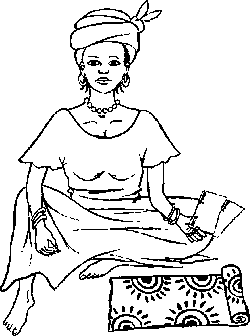
Aminta has saved 10,000 francs. She wants to use the money to start an activity that can make more money. She remembers that her sister-in-law in another part of the country makes tie-dyed cloth. She watched her sister-in-law make the cloth and she has heard about tie-dying on the radio. Aminta decides she will make 5 pieces of cloth and sell them for F2,500 each. “Then I’ll have F12,500.” She is very excited about the idea.
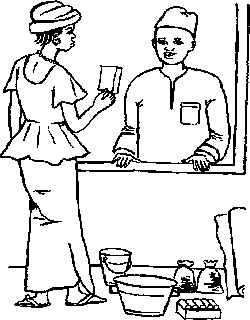
Aminta goes to town and stops at the first store she sees. She buys the supplies she needs and she is surprised that she must spend her entire 10,000 francs. She doesn’t even have money left to take the bus home.
But she walks home happy thinking about how successful her tie-dying is going to be. When she gets home, she goes right to work. She’s never done tie-dying before and she isn’t sure of some of the steps. It’s a lot of work to make the five pieces of cloth.

What is happening here? Why is her husband upset? (Discussion) Yes, the tie-dying took so much time that Aminta couldn’t watch the children and do work around the house. What will happen if Aminta’s husband isn’t happy with her tie-dying work? (Discussion) Still Aminta thinks “My husband may be mad now but he’ll be happy when he sees the F12,500 that I earn.”
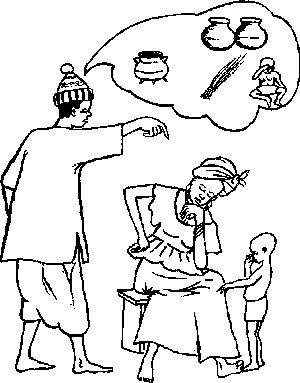
Aminta goes outside to collect her cloth to sell at the market. What does she discover? Two of the pieces are not OK. Why might this be? (Discussion) Aminta thought she would make F12,500 from the sale of the cloth. Now what is the most she can make? Yes 7,500 francs. Aminta has already spent F10,000 on materials and equipment. She is very discouraged and knows she has made a mistake. However, she decides to sell the three pieces and do better next time.
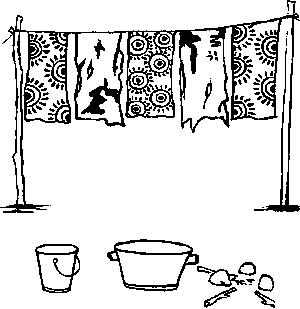
Aminta gets up early the next morning to go to the market, planning to be home by lunchtime. What does she see when she gets to the market? (Discussion) There are many women selling cloth like Aminta’s and they are selling each piece for only 1,000 francs! Since people bargain with the women for the cloth, they often get less than that. Aminta may not even make F3,000! She had hoped to make F7,500. Aminta sits down to sell her cloth. How long do you think it takes?
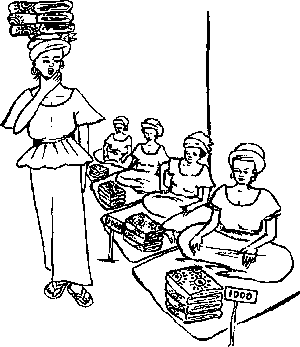
Here is Aminta now. She is very, very disappointed. She can’t understand what she did wrong. Can you help her? What should she have done differently? (Discussion)

Discussion topics:
Aminta did not investigate the market for this product before she decided to make it. So she did not know the prices, how much demand there was, how much can be sold in a day or week or month.
She did not find out find out exactly how to make the cloth. She could have visited her sister-in-law again and practised on old pieces of cloth.
She did not realise how much time it would take to make and sell the cloth. This caused difficulties for her family. It might have been better to work with some friends and help each other.
She bought supplies from the first store she came to - it may not have been the best place and might have been more expensive than necessary.
She used up all her savings and kept nothing in reserve. She could have started on a smaller scale.
She did not work out the production costs to compare to the selling prices to see if the activity would be profitable.
This story is an excellent way of introducing ideas of being “business-like” about what we do and emphasising the importance of gathering information and doing proper planning. You will readily find examples of people in Luapula who have failed to make money from their enterprises, e.g., making and selling mats or buying and selling grain or fish. Just find some people who took loans from CMS and you will find the examples you need.
In the example from Senegal, they go on to show how Aminta succeeded working with some of her friends to make soap, which they were able to sell much more readily. They work their costs out very carefully and calculate that they can make a profit.